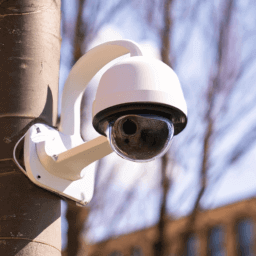What is ptz camera and how it works?
A PTZ camera is a type of surveillance camera that can pan, tilt, and zoom to cover a larger area. It is controlled remotely through a computer, joystick, or mobile device. The camera can rotate 360 degrees horizontally and 90 degrees vertically, allowing it to cover a wide range of angles. The zoom feature allows the camera to capture details from a distance. PTZ cameras are commonly used in security systems, video conferencing, and live broadcasting.
What is PTZ Camera and How it Works?
PTZ stands for Pan, Tilt, and Zoom, which are the three main features of a PTZ camera. A PTZ camera is a type of surveillance camera that is capable of panning, tilting, and zooming to capture a wider area and provide more detailed images. PTZ cameras are commonly used in security systems to monitor large areas such as parking lots, stadiums, and industrial facilities. They are also used in video conferencing systems, webcams, and other applications where remote control of the camera is required.
How Does a PTZ Camera Work?
A PTZ camera is equipped with a motorized mount that allows it to move horizontally (pan) and vertically (tilt) to capture different angles and views. The camera lens is also motorized, allowing it to zoom in and out to capture close-up and distant images. The camera can be controlled remotely using a joystick, keyboard, or software application, allowing the user to adjust the camera's position, zoom, and focus from a remote location.
PTZ cameras are typically connected to a network video recorder (NVR) or a digital video recorder (DVR) that records and stores the video footage. The NVR or DVR can also be used to control the camera's movements and settings. Some PTZ cameras are equipped with built-in microphones and speakers, allowing two-way audio communication between the camera and the user.
Types of PTZ Cameras
There are two main types of PTZ cameras: analog and IP. Analog PTZ cameras are connected to a DVR using coaxial cables and transmit analog video signals. IP PTZ cameras are connected to a network using Ethernet cables and transmit digital video signals. IP cameras are more flexible and scalable than analog cameras, as they can be easily integrated into existing network infrastructures and can be accessed remotely over the internet.
Applications of PTZ Cameras
PTZ cameras are used in a variety of applications, including:
- Security: PTZ cameras are commonly used in security systems to monitor large areas such as parking lots, stadiums, and industrial facilities. They can be programmed to automatically track moving objects and send alerts to security personnel in case of suspicious activity.
- Video Conferencing: PTZ cameras are used in video conferencing systems to provide high-quality video and audio feeds. They can be controlled remotely to adjust the camera's position, zoom, and focus to capture different angles and views.
- Webcams: PTZ cameras are used as webcams in live streaming and video production applications. They can be controlled remotely to adjust the camera's position, zoom, and focus to capture different angles and views.
Comparison Table
| Feature | Analog PTZ Camera | IP PTZ Camera |
|---|---|---|
| Connection | Coaxial cables | Ethernet cables |
| Video Signal | Analog | Digital |
| Integration | Less flexible | More flexible |
| Remote Access | Not as easy | Easier |
| Image Quality | Lower resolution | Higher resolution |
| Cost | Less expensive | More expensive |
| By www.zelect.in | ||
Sharing is caring!
Facebook Twitter Email
Recommended articles for CCTV Camera
CCTV Camera types and buying guide
-
CCTV Camera Buying Guide. How to Choose the Right CCTV Camera?
-
Understanding the CCTV camera types their pros and cons
-
Advantages and Disadvantages of Wireless CCTV Cameras
-
Dome camera vs bullet camera which is better
-
What is ptz camera and how it works?
-
What is pan tilt zoom camera?
-
What is dvr in CCTV camera
-
What is the best CCTV camera for night vision
-
What is CCTV camera and how it works
-
What is dome camera and how it works?
-
What is bullet camera and how it works?
-
What is ip CCTV camera and how it works?
-
Why CCTV camera quality is bad
-
What is motion detection in CCTV camera
-
What is CCTV camera face detection
-
What is difference between dvr and nvr in CCTV


